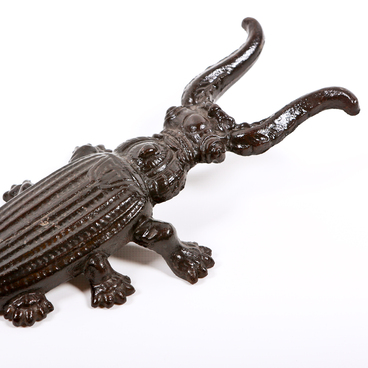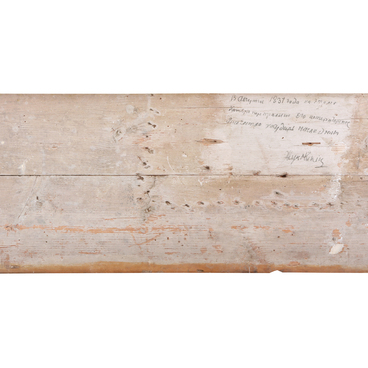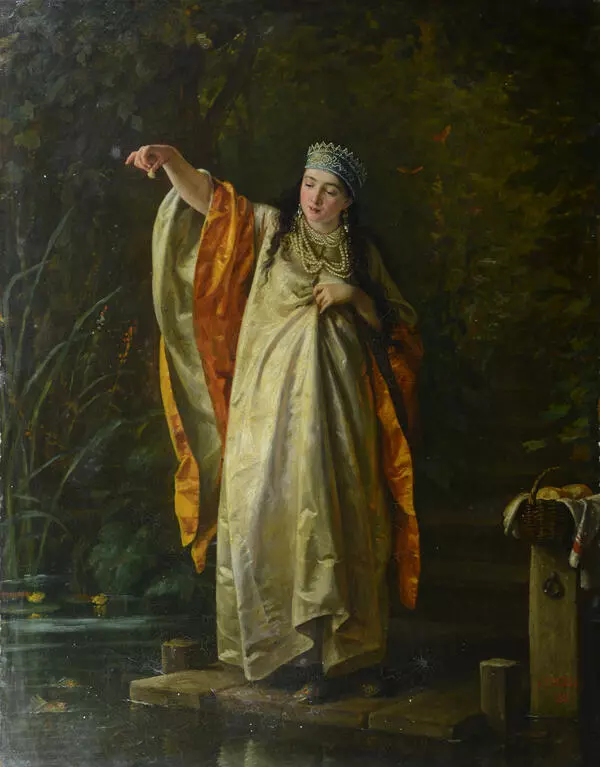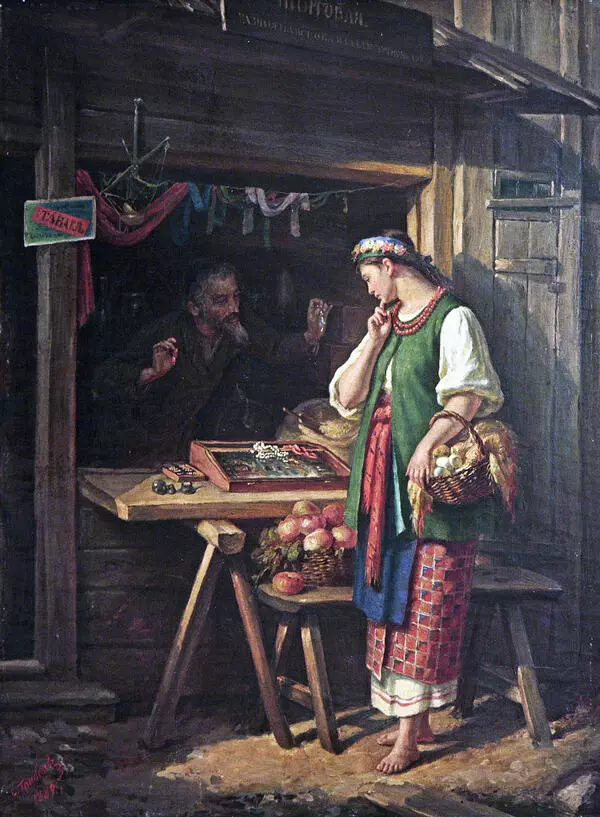In the exhibition of the Kasimov Museum-Reserve, one can see the painting ‘Sweetheart’. It was painted by Sergei Gribkov. The artist was born in Kasimov but studied painting and worked in Moscow.
‘Sweetheart’ is a small-sized portrait of a teenage girl. She is dressed in a white semi-transparent dress, her hair is gathered on the back of her head, and her cheeks are slightly blushed. Most likely, the girl came from a middle-class or a merchant family.
In his works, Sergei Gribkov carefully painted out the smallest details and tried to achieve a realistic image. This feature can be seen in the ‘Sweetheart’ as well: with the help of a thin brush, the artist painted the folds of a fluffy outfit, small earrings in the ears, and a mole on the girl’s neck.
Sergei Gribkov had a long and difficult life. He was born in a family of poor Kasimov merchants and began to paint after he turned 20 years old — in the 19th century, it was considered a late start of the career.
Despite this, Gribkov succeeded in painting many canvases. He worked in various genres: he created portraits, paintings on historical subjects. He even painted cathedrals — for example, the walls of the Ascension Cathedral in his native Kasimov and the cathedral of the town of Lasby in Denmark.
However, Sergei Gribkov achieved the greatest success as a genre painter. In his works, he explored the image of a “simple man” and his daily life. Therefore, he often painted ordinary people at work. The paintings “Laundress”, “Peasant Shears the Sheep”, “Clerks” Carouse’ brought him fame.
As remembered by fellow men, Gribkov was a very kind and sensitive person. He had his art studio, where he taught young painters. Gribkov was also friends with experienced colleagues, supported them, and helped them occasionally. Among his friends were Vasily Pukirev, Pyotr Shmelkov, Alexey Savrasov, and others.
The last years of his life Sergei Gribkov spent in poverty. In 1893, the artist died, and his friends and students collected money for the funeral. The writer Vladimir Gilyarovsky recalled that ‘there was not a penny in the house.’
Now, Sergei Gribkov’s paintings are housed in the State Tretyakov Gallery in Moscow, the Russian Museum in St. Petersburg, the Ryazan Art Museum named after I. P. Pozhalostin, as well as in the galleries of Irkutsk, Vologda, Tambov, Tver.
‘Sweetheart’ is a small-sized portrait of a teenage girl. She is dressed in a white semi-transparent dress, her hair is gathered on the back of her head, and her cheeks are slightly blushed. Most likely, the girl came from a middle-class or a merchant family.
In his works, Sergei Gribkov carefully painted out the smallest details and tried to achieve a realistic image. This feature can be seen in the ‘Sweetheart’ as well: with the help of a thin brush, the artist painted the folds of a fluffy outfit, small earrings in the ears, and a mole on the girl’s neck.
Sergei Gribkov had a long and difficult life. He was born in a family of poor Kasimov merchants and began to paint after he turned 20 years old — in the 19th century, it was considered a late start of the career.
Despite this, Gribkov succeeded in painting many canvases. He worked in various genres: he created portraits, paintings on historical subjects. He even painted cathedrals — for example, the walls of the Ascension Cathedral in his native Kasimov and the cathedral of the town of Lasby in Denmark.
However, Sergei Gribkov achieved the greatest success as a genre painter. In his works, he explored the image of a “simple man” and his daily life. Therefore, he often painted ordinary people at work. The paintings “Laundress”, “Peasant Shears the Sheep”, “Clerks” Carouse’ brought him fame.
As remembered by fellow men, Gribkov was a very kind and sensitive person. He had his art studio, where he taught young painters. Gribkov was also friends with experienced colleagues, supported them, and helped them occasionally. Among his friends were Vasily Pukirev, Pyotr Shmelkov, Alexey Savrasov, and others.
The last years of his life Sergei Gribkov spent in poverty. In 1893, the artist died, and his friends and students collected money for the funeral. The writer Vladimir Gilyarovsky recalled that ‘there was not a penny in the house.’
Now, Sergei Gribkov’s paintings are housed in the State Tretyakov Gallery in Moscow, the Russian Museum in St. Petersburg, the Ryazan Art Museum named after I. P. Pozhalostin, as well as in the galleries of Irkutsk, Vologda, Tambov, Tver.







